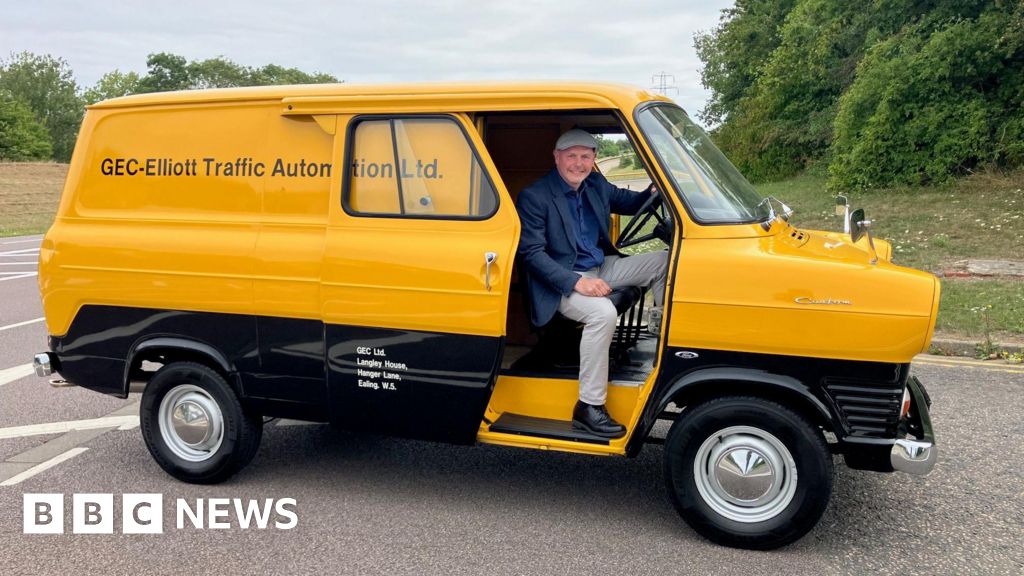Worldwide Enterprise Correspondent
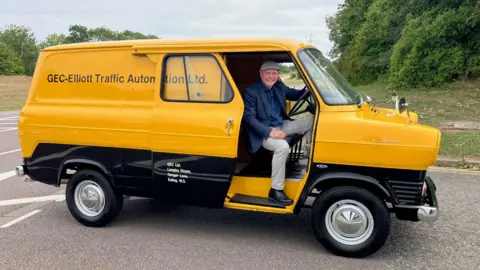 BBC
BBCClimbing right into a 1965 Ford Transit is like stepping right into a time capsule on wheels.
Neglect your fashionable high-tech nicknacks like satnavs and touchscreens. All you get here’s a steering wheel, a giant chrome-lined speedometer dial and a chunky heater management. There is not even a radio.
Out on the street, it rattles and bangs and infrequently jumps out of substances.
Disconcertingly, there is not any seatbelt, the seat itself has an alarming tendency to maneuver round, and the brakes do not appear to do very a lot in any respect.
Lovely as it’s, it is exhausting to think about that this aged machine was ever cutting-edge.
But when the unique Transit first rolled off the manufacturing line at Ford’s plant in Langley, Berkshire, on 9 August 1965, it was a revelation.
By the requirements of the day, it was remarkably spacious, highly effective and sensible. It was comfy, had sharp dealing with, and put current vans such because the Morris J4 firmly within the shade.
Sixty years later, the Transit has been redesigned many occasions, however the model itself remains to be going robust. It stays a staple for a lot of small companies, even in an age when “white vans” are ten a penny, and the market is rife with competitors.
It’s the world’s best-selling van – and greater than 13 million have been constructed up to now.
“There are many iconic automobiles: the Morris Minor, the Mini, the Land Rover, the VW Beetle, however there’s just one iconic van, and that is the Transit,” says Edmund King, president of the AA.
“It is most likely the one van that folks actually know”.
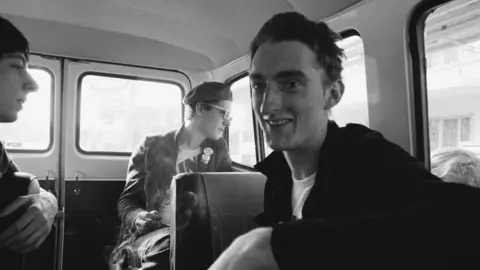 Erica Echenberg by way of Getty Pictures
Erica Echenberg by way of Getty PicturesInitially a collaboration between Ford’s engineers within the UK and Germany, and primarily aimed on the British and European markets, the Transit was designed to be as versatile as attainable.
It quickly grew to become a staple for tradespeople, together with builders, carpenters, electricians and supply drivers.
However it additionally appealed to others searching for spacious, low cost transport – together with aspiring rock bands. It was virtually a ceremony of passage. Amongst those that hung out on the street in a single have been Black Sabbath, Led Zeppelin, the Small Faces and Slade.
“It was the liberty to go the place you need, whenever you need. Petrol was so much cheaper than it’s now,” says Peter Lee, founding father of the Transit Van Membership.
“I ended up in Spain, lived in a single for 13 months as a hippy on a strawberry farm, then got here again and began a enterprise. Earlier than you realize it, I had 180 staff in 28 Transit vans driving round London.”
The Transit’s pace and loading area additionally appealed to folks on the improper aspect of the regulation.
In 1972, so the story goes, a Metropolitan Police spokesman claimed Transits have been being utilized in 95% of financial institution raids, including that its pace and loading area meant it had turn into the right getaway automobile. This, he commented drily, made it “Britain’s most wished van”.
In the meantime the stereotype of the bullying “white van man”, outlined by Sunday Instances reporter Jonathan Leake in 1997 as “a tattooed species, typically with a cigarette in his mouth, who’s susceptible to flashing his lights as he descends on his prey”, didn’t particularly goal Transit drivers.
However given what number of of them have been on the street by then, it’s a truthful wager they have been implicated.
For practically half a century, Transits have been inbuilt Britain – first at Langley, then at a manufacturing facility simply outdoors Southampton. However this closed in 2013, as Ford eliminated manufacturing to Turkey, the place it stated prices have been “considerably decrease”. It was a controversial transfer that put tons of of workers out of labor. It was described by unions as a ‘betrayal’.
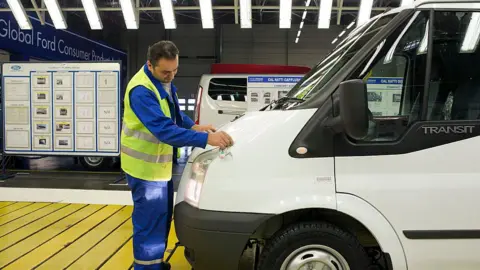 Bloomberg by way of Getty Pictures
Bloomberg by way of Getty PicturesIn the present day, Ford continues to spotlight each the Transit’s British heritage and the work that also takes place right here, particularly at its UK headquarters in Dunton, Essex.
“Dunton is the house of the Transit,” insists Ford of Britain’s managing director, Lisa Brankin
“It is the place we handle all of the engineering and design work for the brand new vans. However we additionally construct our diesel engines in Dagenham, simply down the street, and we make energy packs for electrical vans in Halewood, close to Liverpool.”
A lot of the firm’s European manufacturing stays in Turkey, and that appears unlikely to alter.
“It is about effectivity and simply centring manufacturing into one place, fairly than having a number of websites throughout Europe,” Ms Brankin explains.
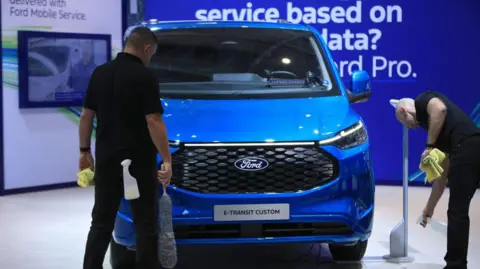 Bloomberg by way of Getty Pictures
Bloomberg by way of Getty PicturesA lot of the exercise at Dunton now’s targeted on what the subsequent technology of Transit vans will deliver. However will there ever be one other radical game-changer like the unique mannequin?
“We’re engaged on it,” says director of economic automobile improvement Seamus McDermott, after I ask him that query.
He believes that what prospects need from a van has probably not modified in 60 years. It’s nonetheless all about having a dependable set of wheels that’s versatile and low cost to run. However the best way that purpose is achieved is now very completely different.
“Electrical autos are cheaper to run and cheaper to restore,” he says.
“Additionally, once we deliver in additional software program outlined, ‘smarter’ autos, the power to handle fleets remotely will assist deliver down prices as properly. So the revolution might be about propulsion and software program.”
However whereas the Transit model has already endured for 60 years, right this moment it’s heading into an unsure future, in line with AA president Edmund King.
“Within the 60s, 70s and 80s, if somebody’s father had a Transit, they might get a Transit,” he says.
“I feel that is altering now. There’s extra competitors throughout the van market, and subsequently model loyalty is definitely not as robust because it was once.”
